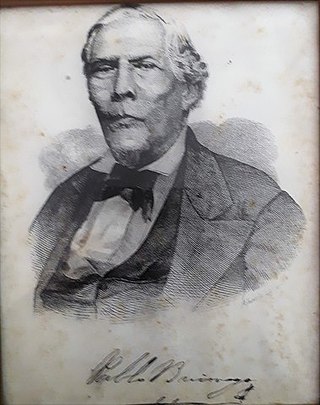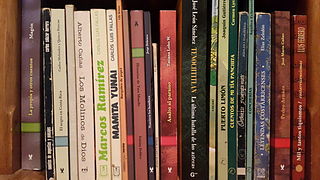Alberto Oreamuno Flores was a Costa Rican physician and politician, first Vice President of Costa Rica of the Second Republic.
Miguel de Bonilla y Laya-Bolívar (1763–1826) was a Costa Rican Roman Catholic priest and politician. He was one of the signatories of the Costa Rican Declaration of Independence.
José Francisco de Peralta y López del Corral was a Costa Rican priest and politician. He was born in Cartago, Costa Rica, the son of José María de Peralta y La Vega and Ana Benita de Nava López del Corral. Peralta attended the University of León and was ordained as a pastor in León, Nicaragua in 1812. He was named a parish priest for the village Olocuilta, El Salvador.
Tranquilino de Bonilla y Herdocia was a nineteenth-century Costa Rican politician. He came from Cartago. His parents are Félix de Bonilla y Pacheco and Rafaela Herdocia Fernández de la Pastora. He married Sinforosa de Peralta y López del Corral, the daughter of José María de Peralta y La Vega y Ana Benita Nava López del Corral.

The following is an alphabetical list of topics related to the Republic of Costa Rica.

Pablo Sánchez de Buitrago Sandoval y Benavente was a legitimist Nicaraguan politician who served as the 2nd Supreme Director of Nicaragua from 4 March 1841 to 1 April 1843. He was the first non-acting, elected Supreme Director.

Costa Rican literature has roots in colonization and is marked by European influences. Because Costa Rica is a young country, its literary tradition is also young. The history of Costa Rican literature dates to the end of the 19th century.

José María Alfaro Zamora was the Costa Rican Head of State between the periods of 1842 and 1844 as well as 1846 and 1847 and President of Costa Rica between May 1 and May 8, 1847.

Francisco María Oreamuno Bonilla was a Costa Rican politician and the Head of State of Costa Rica from November to December 1844.
Joaquín Mora Fernández was the provisional head of state of Costa Rica from 1 March to 17 April 1837.
The Ochomogo War was a civil war fought in Costa Rica, the first in its history, and was fought shortly after the country became independent from Spain.

Joaquín Mariano de Oreamuno was a Costa Rican who led a coup in 1823 that attempted to make Costa Rica part of the First Mexican Empire. A few days later the imperialist forces were defeated by republicans under Gregorio José Ramírez in the Battle of Ochomogo.
Head of State elections were held in Costa Rica in 1844. They were the first in which direct suffrage was used to elect the Head of State, in accordance with the provisions of the Constitution of 9 April 1844. Direct election was abolished by the next election, with presidential elections returning to indirect suffrage until 1913.

The Free State of Costa Rica was the name acquired by Costa Rica after its split from the Federal Republic of Central America in 1838 and until the proclamation of the First Costa Rican Republic in 1847.

The history of the Costa Rican legislature is long and starts from even before its formal independence from the Spanish Empire. Costa Rica is one of the world's oldest democracies, thus, its parliamentary history dates back several centuries.
The First Political Statute of the Province of Costa Rica was issued on March 19, 1823 by the newly independent provisional government and replaced the Pact of Concord as its Political Constitution.
The Second Political Statute of the Province of Costa Rica was issued on May 16, 1823 by the interim government and the Second Provincial Congress of the Province of Costa Rica. It was issued just after the Ochomogo War when the monarchist camp settled in Cartago and Heredia and headed by Joaquín de Oreamuno as its commander of arms, was defeated by the Republican side commanded by Gregorio José Ramírez and gravitated around San José and Alajuela.

Gregorio José Ramírez y Castro (1796–1823) was a Costa Rican politician, merchant and marine who was most notable for being the 2nd General Commander of Arms of Costa Rica from April 5 to April 16, 1823.

From January 1822 to July 1823, the Captaincy General of Guatemala, a former Spanish colony, was controlled by the First Mexican Empire, and briefly, the Supreme Executive Power—the provisional government that succeeded Mexican imperial rule. The captaincy general consisted of the provinces of Chiapas, Costa Rica, El Salvador, Guatemala, Honduras, and Nicaragua—the six southernmost provinces of the Mexican Empire. The incorporation of Central America brought Mexico to the height of its territorial extent.










